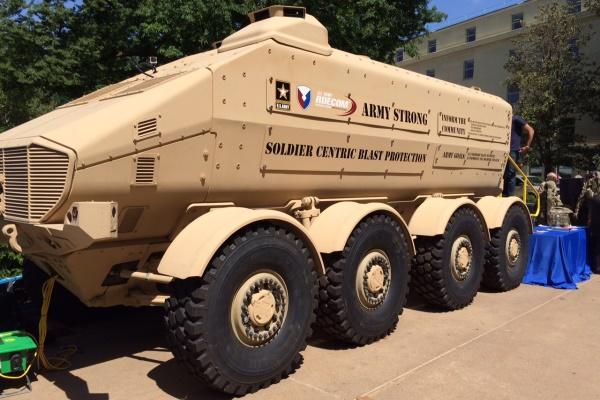The service branches on Thursday showed off advances in technology in development for the future battlefield - from better blast protection and improved aircraft guidance systems, to an unmanned jet ski and longer-lasting pizza.
Deputy Defense Secretary Bob Work said the displays represented the cutting edge of military science aimed at "retaining our technological superiority" against an enemy.
"Technological superiority is not an American birthright. We assume it," but the U.S. lead in advanced weaponry was now under threat from other nations, Work said. The labs of the service branches were "going to help us avoid technological surprise," Work said.
More than 100 exhibits featuring more than 60 innovations from the Army, Marines, Navy, and Air Force medical laboratories and engineering centers across the country were on display in the Pentagon's courtyard at the military's first ever "Lab Day."
Among the exhibits was the Army's CAMEL -- or Concept for Advanced Military Explosion-Mitigating Land demonstrator - the largest vehicle on display.
The hulking vehicle mockup meant to test safety advances and blast protection in future Army vehicles featured a radical change in design concept, said Dr. Mary Williams, a special assistant to Alan Shaffer, the assistant secretary of Defense for Research.
"We thought what if we turned (military vehicle) design on its head and started with the human and designed out from there," Williams said.
The result was that the CAMEL was "designed around the occupant, not around the mission," said Joseph Kott III, the project leader on blast mitigation at Army TARDEC (Tank Automotive Research, Development and Engineering Center).
The CAMEL on display featured an improved V-hull design over the current ones on the MRAP (Mine Resistant-Ambush Protected) to deflect the blast energy of improvised explosive devices (IEDs) that were the major cause of casualties in Iraq and Afghanistan.
In addition, the CAMEL also had an enlarged cabin and form-fitting seats that could slide up to absorb the force of a blast. The floor of the cabin was not welded to the sides and could also slide up and ease the blow of the slam-down as the vehicle settled back on the road.
"Everything is about the vehicle absorbing the force of the blast to save the occupants," said Williams.
At another corner of the Pentagon's courtyard, Jeremy Whitsitt, deputy director of the Combat Feeding Directorate at the Natick Soldier Research Center, was serving what could be called Army oer d'oeuvres - or items to be found in Meals Ready to Eat of the future.
The idea was to come with military rations that were "nutritionally dense and lighter in weight" through new food processing technology that allowed the Army to "inject energy into the product," Whitsitt said.
The result was micro-dried pomegranates, micro-dried mango powder, brownies enriched with Vitamin D, and "shelf-stable pizza." Whitsitt said the long-lasting pizza might be ready for distribution to the troops by 2017.
Other exhibits included the Air Force' "BATMAN" display - short for the Battlefield Air Targeting Man Aided kNowledge program -- aimed at improving the gear carried by troops in the field. One innovation was methanol batteries that lose weight as they are used up, lightening the load for troops.
The Navy displayed its "Magic Carpet" - a new series of flight-control algorithms in development to allow for smoother carrier landings for FA-18 Super Hornets.
-- Richard Sisk can be reached at Richard.Sisk@military.com



























